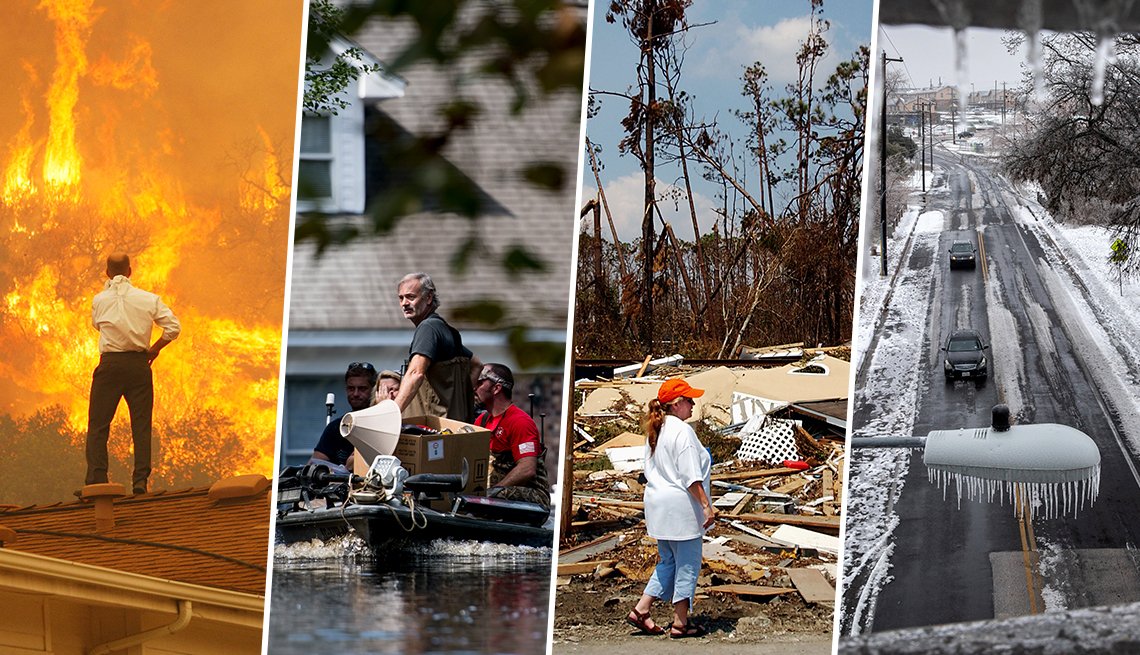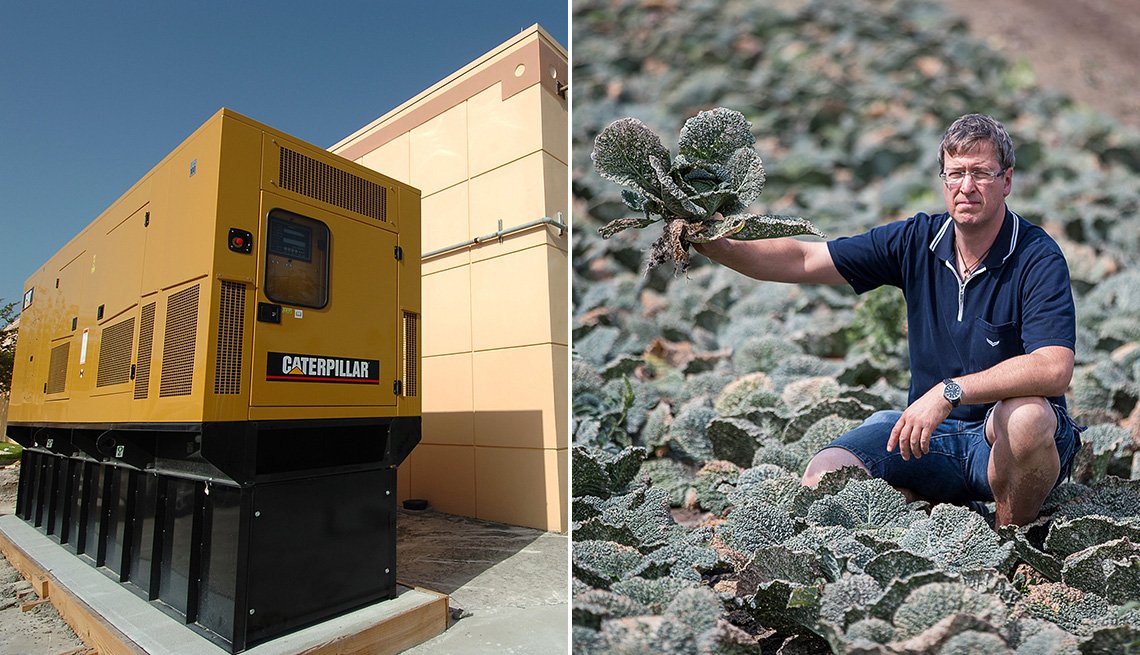What You Need to Know About Climate Change
How it's already affecting your health, home and safety — and what you can do about it
by David Hochman, Sari Harrar, Laura Petrecca and Brian Barth, AARP, June 1, 202
Remember the Great Texas Freeze this past February? Never-before-seen ice storms crashed trees onto power lines and froze the wind turbines Texans turn depend on for heat and light. Record-breaking temperatures gave way in some places to snowfalls not seen since the Truman administration. Then the pipelines that supply natural gas to power plants froze up. Families huddled for warmth in the dark for days, and the nation watched their misery on TV.
Now let's recall the California fires of 2020, with nearly 10,000 blazes that consumed more than 4.2 million acres of forest and killed 33 people. The North Complex fire alone was responsible for more than 300,000 acres of scorched land, leaving 16 people dead in its wake. Last year's fire season was the worst in California history, claiming countless ancient redwoods and sequoias and changing the natural face of the Golden State forever. Once again, extreme weather played a role: Lightning and a record-breaking heat wave, combined with Diablo and Santa Ana winds, sparked wildfires that kept California on the nightly news for much of the summer.
Those are extreme weather events, but even the everyday has become more extreme. Scientists have been measuring air temperature since the 1880s, and 2020 was Earth's second hottest of the past 140 years, according to the National Oceanic and Atmospheric Administration. Moreover, 19 of the warmest years on record have occurred since 2000. No matter what you may think about the causes, the climate is changing, and the repercussions of this are no longer some distant concern. With rising temperatures and more violent weather come a host of issues that affect how older Americans live — from where we choose to reside and new health risks we face to whether we can still pursue the lifestyles we've long hoped for.
To assess these risks, the AARP Bulletin talked with more than three dozen experts and reviewed more than 90 studies. Here is what they say is the current and near-term impact of climate change on older Americans, in four categories: your finances, your choice of home, your health and your day-to-day activities. The experts also share their advice on what to do to mitigate these issues now — and if or when they become more severe.
Risk: Greater storm risk
Impact: Rising home insurance rates
Someone has to pay for the devastation of the freezes, floods, hurricanes and fires that increasingly lead the news, and we the people will likely foot that bill through higher insurance outlays. Annual rates are soaring on homeowners policies in storm-ravaged Louisiana and Florida, where premiums are now more than $3,000 a year, even with relatively low rebuilding costs, according to the Insurance Information Institute. Some California residents saw their fire insurance jump 300 percent in 2019 after big burns there.
But another factor in rate increases is uncertainty. “If insurance companies fear that the worst-case scenarios might get even worse, they will have to prepare for that, requiring higher premiums,” says Robert Erhardt, who researches environmental and climate statistics at Wake Forest University. For instance, a storm delivering 40 inches of rain over four days in Texas was nearly unfathomable — until Hurricane Harvey in 2017. After that, actuaries recalculated the odds to 18 percent for a similar or bigger storm by the end of the 21st century because of climate change. That means higher bills.
With more than $20 billion in debt from hurricane payouts, the Federal Emergency Management Agency (FEMA) National Flood Insurance Program raised premiums in 2020 by an average of 11.3 percent, and much more for properties in the most flood-prone zones. All of this is also leading to an overhaul of the system. FEMA will soon unveil “Risk Rating 2.0,” the biggest change to the way flood insurance premiums are calculated since the inception of the program in 1968, with new rates set to take effect Oct. 1.
And you don't have to live in harm's way to feel rates rise. The $20 billion to $25 billion in claims paid out after Harvey “gets passed along to customers even if you live in Washington or Maine,” says David Havens, who covers the insurance sector for investment bank Imperial Capital. “When individual insurance rates go up after a large loss, wholesale rates go up even more, and insurance companies have to recoup those losses.”
Impact: More expensive groceries
Think you spend a lot at the supermarket? Consider that last summer, at least a third of Iowa's corn, soy and other crops were wiped out by powerful derechos, which caused devastating wind damage and torrential rains in the Midwest. Extreme weather also hurt the supply of a favorite beverage: Last year's California wine grape crop decreased by 14 percent, largely because of wildfires.
Overall, the cost of food in 2020 increased by more than double the rate of the year before, the Consumer Price Index shows. Of course, the pandemic caused some production and distribution disruptions, but experts note that the climate contributed as well and will keep prices higher. Even more vulnerable are specialty crops such as coffee, cacao, tea, honey and vanilla beans. Says Amanda Little, author of The Fate of Food, “We will likely see more shortages and cost increases for the most delicious foods."
Climate change poses an even greater risk in other parts of the world: Some populations in the Middle East and eastern Africa face famine.
Impact: More “green” investment
Within any crisis, opportunity and hope arise. Companies are investing in green technologies, and their successes could boost your retirement or investment funds. “Green investing” is red hot, with investors snapping up stocks, bonds and funds that focus on environmental sustainability.
In recent years, the number of investment opportunities in the ESG category (environmental, social and governance) has skyrocketed, with close to 400 ESG open-end funds and exchange-traded funds, according to fund tracker Morningstar. Some are investing in such assets as green bonds, wind power stocks and clean energy funds.
The additional choices give retirees and those approaching retirement options for diversification, says Mitchell Kraus, a financial planner and chartered socially responsible investing consultant in Santa Monica, California.
"Most ESG investments either outperform or perform similarly to conventional investing,” says Tensie Whelan, founding director of New York University's Stern Center for Sustainable Business, citing a meta-analysis of more than 1,000 research papers the center conducted with Rockefeller Asset Management.
Yet just like any type of investing, risks remain. Investors could lose money, Whelan warns. And since there's no universal, agreed-upon standard as to what qualifies as an ESG, there's “wiggle room” for interpretation, she says.




 RSS Feed
RSS Feed